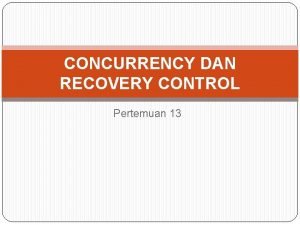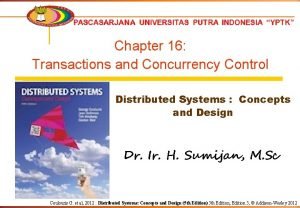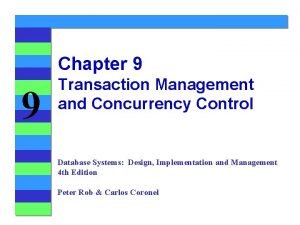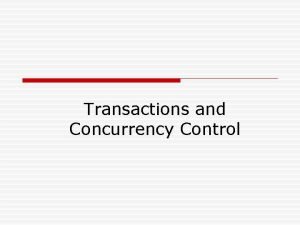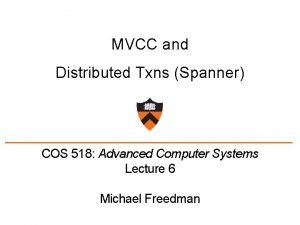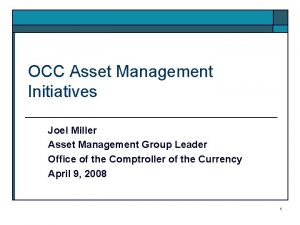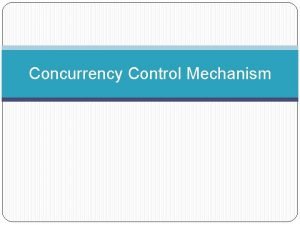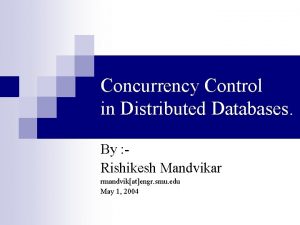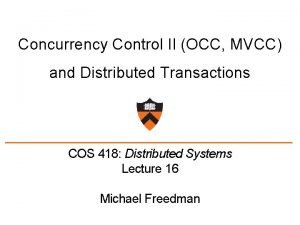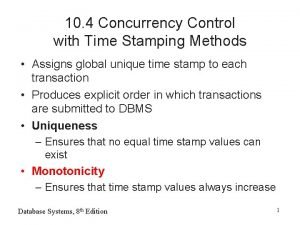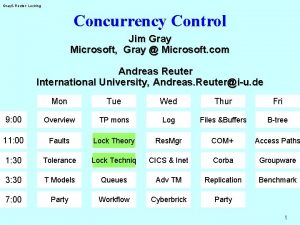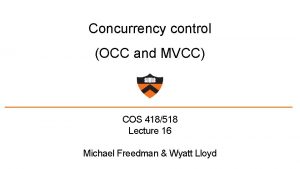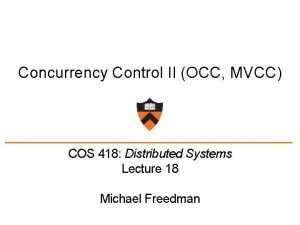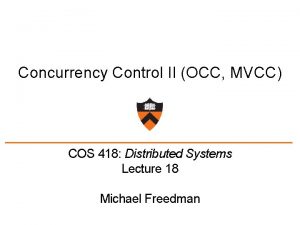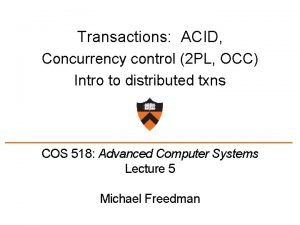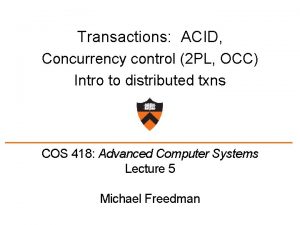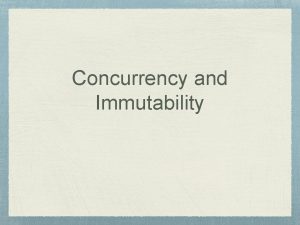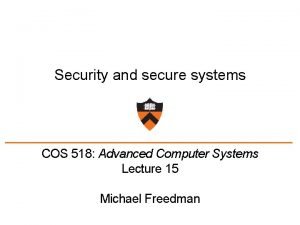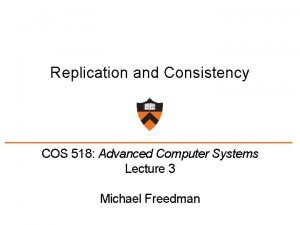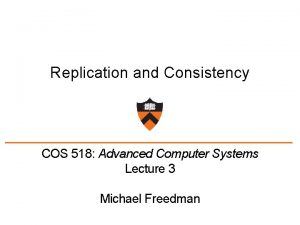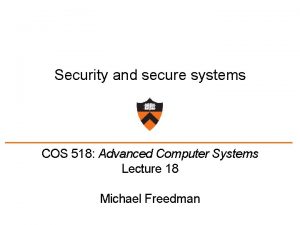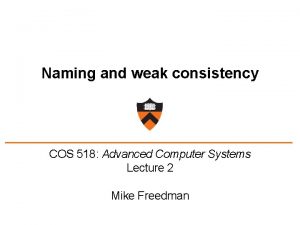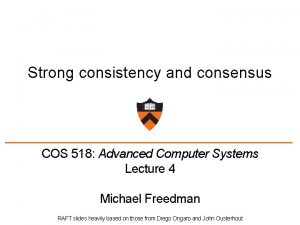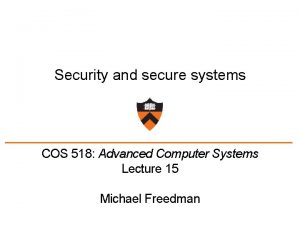Concurrency control OCC and MVCC COS 518 Advanced




















- Slides: 20

Concurrency control (OCC and MVCC) COS 518: Advanced Computer Systems Lecture 6 Michael Freedman

Q: What if access patterns rarely, if ever, conflict? 2

Be optimistic! • Goal: Low overhead for non-conflicting txns • Assume success! – Process transaction as if would succeed – Check for serializability only at commit time – If fails, abort transaction • Optimistic Concurrency Control (OCC) – Higher performance when few conflicts vs. locking – Lower performance when many conflicts vs. locking 3

OCC: Three-phase approach • Begin: Record timestamp marking the transaction’s beginning • Modify phase: – Txn can read values of committed data items – Updates only to local copies (versions) of items (in db cache) • Validate phase • Commit phase – If validates, transaction’s updates applied to DB – Otherwise, transaction restarted – Care must be taken to avoid “TOCTTOU” issues 4

OCC: Why validation is necessary txn coord When commits txn updates, create new versions at some timestamp t O • New txn creates shadow copies of P and Q • P and Q’s copies at inconsistent state P txn coord Q 5

OCC: Validate Phase • Transaction is about to commit. System must ensure: – Initial consistency: Versions of accessed objects at start consistent – No conflicting concurrency: No other txn has committed an operation at object that conflicts with one of this txn’s invocations 6

OCC: Validate Phase • Validation needed by transaction T to commit: • For all other txns O either committed or in validation phase, one of following holds: A. O completes commit before T starts modify B. T starts commit after O completes commit, Read. Set T and Write. Set O are disjoint and C. Both Read. Set T and Write. Set T are disjoint from Write. Set O, and O completes modify phase. • When validating T, first check (A), then (B), then (C). If all fail, validation fails and T aborted 7

2 PL & OCC = strict serialization • Provides semantics as if only one transaction was running on DB at time, in serial order + Real-time guarantees • 2 PL: Pessimistically get all the locks first • OCC: Optimistically create copies, but then recheck all read + written items before commit 8

2 PL & OCC = strict serialization • Provides semantics as if only one transaction was running on DB at time, in serial order + Real-time guarantees • 2 PL: Pessimistically get all the locks first • OCC: Optimistically create copies, but then recheck all read + written items before commit 9

Multi-version concurrency control Generalize use of multiple versions of objects 10

Multi-version concurrency control • Maintain multiple versions of objects, each with own timestamp. Allocate correct version to reads. • Prior example of MVCC: 11

Multi-version concurrency control • Maintain multiple versions of objects, each with own timestamp. Allocate correct version to reads. • Unlike 2 PL/OCC, reads never rejected • Occasionally run garbage collection to clean up 12

MVCC Intuition • Split transaction into read set and write set – All reads execute as if one “snapshot” – All writes execute as if one later “snapshot” • Yields snapshot isolation < serializability 13

Serializability vs. Snapshot isolation • Intuition: Bag of marbles: ½ white, ½ black • Transactions: – T 1: Change all white marbles to black marbles – T 2: Change all black marbles to white marbles • Serializability (2 PL, OCC) – T 1 → T 2 or T 2 → T 1 – In either case, bag is either ALL white or ALL black • Snapshot isolation (MVCC) – T 1 → T 2 or T 2 → T 1 or T 1 || T 2 – Bag is ALL white, ALL black, or ½ white ½ black 14

Timestamps in MVCC • Transactions are assigned timestamps, which may get assigned to objects those txns read/write • Every object version OV has both read and write TS – Read. TS: Largest timestamp of txn that reads OV – Write. TS: Timestamp of txn that wrote OV 15

Executing transaction T in MVCC • Find version of object O to read: – – # Determine the last version written before read snapshot time Find OV s. t. max { Write. TS(OV) | Write. TS(OV) <= TS(T) } Read. TS(OV) = max(TS(T), Read. TS(OV)) Return OV to T • Perform write of object O or abort if conflicting: – Find OV s. t. max { Write. TS(OV) | Write. TS(OV) <= TS(T) } – # Abort if another T’ exists and has read O after T – If Read. TS(OV) > TS(T) • Abort and roll-back T – Else • Create new version OW • Set Read. TS(OW) = Write. TS(OW) = TS(T) 16

Distributed Transactions 25

Consider partitioned data over servers O P L R L Q U R W U L W U • Why not just use 2 PL? – Grab locks over entire read and write set – Perform writes – Release locks (at commit time) 26

Consider partitioned data over servers O P Q L R L U R W U L W U • How do you get serializability? – On single machine, single COMMIT op in the WAL – In distributed setting, assign global timestamp to txn (at sometime after lock acquisition and before commit) • Centralized txn manager • Distributed consensus on timestamp (not all ops) 27

Strawman: Consensus per txn group? O P Q L R L U R W U L W U R S • Single Lamport clock, consensus per group? – Linearizability composes! – But doesn’t solve concurrent, non-overlapping txn problem 28
 Tarpit java
Tarpit java Gezang 161
Gezang 161 Pessimistic concurrency control
Pessimistic concurrency control Pengertian concurrency
Pengertian concurrency Transactions and concurrency control in distributed systems
Transactions and concurrency control in distributed systems Transaction management and concurrency control
Transaction management and concurrency control Advantages of two phase locking protocol in dbms
Advantages of two phase locking protocol in dbms Transaction management and concurrency control
Transaction management and concurrency control Occ.edready
Occ.edready Occ bulletin 2007-21
Occ bulletin 2007-21 Occ new student orientation
Occ new student orientation Occ systems
Occ systems Modelo occ
Modelo occ Occ contador
Occ contador Occ bulletin 2017-21
Occ bulletin 2017-21 Occ investment management handbook
Occ investment management handbook Pitfalls of lock based protocol
Pitfalls of lock based protocol Concurrency control in distributed databases
Concurrency control in distributed databases Concurrency control in distributed transactions
Concurrency control in distributed transactions Concurrency control with time stamping methods
Concurrency control with time stamping methods Jim gray microsoft
Jim gray microsoft



